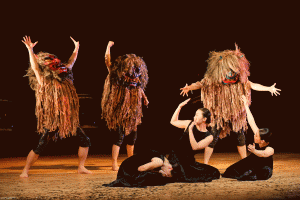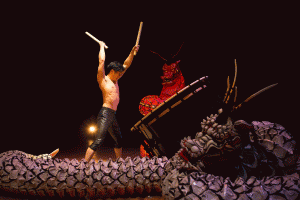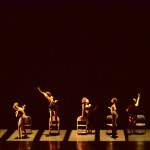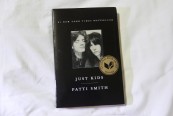There is a common misperception of taiko, a traditional Japanese drum, in the contemporary world. The current landscape of taiko is losing touch with the artistic and intellectual integrity of traditional taiko music. The majority of taiko groups have embraced the Westernized fast rhythms and thunderous drumming that have become a trope of taiko drumming. Compositions sound increasingly similar to drumline, a Western musical ensemble where rhythmic patterns and polyrhythmic beats are prioritized over musicality. The odaiko is a large drum one plays while standing, and it has become emblematic of taiko because it is more about showmanship of endurance than taiko’s artistic tradition. Whoever plays fastest and loudest for the longest seems to earn the most respect.
What once set taiko and Japanese music apart from Western music was its different sense of time and composition. Taiko is more than 2000 years old. Like many things in Japanese culture such as chopsticks or kanji, it has origins in China with influences from Korea. It was used during warfare for communication, in temples and shrines for rituals, and in theatrical settings for accompaniment. Today it is better known as kumi-daiko, which refers to an ensemble with multiple drums.
Traditional Japanese musical aesthetic utilizes the ma, the space between the actual strikes, as the driving force of songs. The beauty comes from what is not being played. It is a quiet, refined aesthetic. Japanese traditional music does not follow Western notations, thus taiko cannot be measured in time signatures of 4/4 or 3/4. The composition of songs is much more intricate, because the musicality of a phrase is emphasized over rhythmic patterns. Taiko is also very much a dance, influenced by kabuki movements. Choreography is just as important as the song itself.
Kodo, a professional Japanese taiko drumming troupe, has taken a more modern route, making its name by showcasing rhythmic synchronization with powerful drummers. They are the largest professional taiko group in the world with a strong international presence, continually touring in Japan, America, and Europe.
Recently Kodo has become a familiar act, stopping by Chicago every two years. They took the stage earlier this year at the Chicago Symphony Center, directed by famed kabuki actor Tamasaburo Bando. The theme was “mystery.” This was Bando’s second production. “I created this piece with the idea that theatre-goers would experience the mood of mystery that they meet at a temple or a shrine,” Bando writes on Kodo’s website, “or when you go into the forest — places that are removed from daily life. A feeling that emerges from deep darkness.”
The sense of mystique and darkness was prevalent throughout the performance, opening with a droning (albeit stereotypical) gong. Three large paper snakes were then introduced, performing a short dance. The snakes, shishi mai (lion dance) and namahage (demon-like ogre) reference the sacredness of religious rituals, often shrouded in elegant yet mysterious splendor.
This iteration of the “Mystery Tour” had a very contemporary feel. There were no traditional costumes such as kimono or yukata save for one section in the namahage act where three ladies wore basic happi, a traditional Japanese straight-sleeved coat. Instead the men were bare chest and wore shiny leggings, while the women were outfitted in basic black dresses and leggings. This tour was also comprised of younger performers, which may explain the trend for the more contemporary presentation and the commercial appeal.
Bando played very successfully with lighting to push the concept of theatre and mystique. In one song a procession of performers had lamps curving from backpacks over the performers’ heads a bit like anglerfish. The stage was shrouded in darkness, so the audience was focused on the movement of the lights. The brightness of the lamps could be adjusted, and this was incorporated into the choreography. At one point, the performers carried portable spotlights, lighting other drummers as they played, exploring the idea of functionality versus theatricality.
In other moments Bando perhaps tried too hard to entertain. One song used the smaller shime taiko drum, and as the drummers began what seemed to be a technically rigorous piece, the performers suddenly turned the drums around towards the audience. They then proceeded to tap, smack, and squeegee the taiko with their hands, creating unconventional sounds and making new rhythms. The piece was enacted as a comedy, where one member failed to make the right sound as the other members played together. Although entertaining and funny it was highly reminiscent of a Blue Man Group act, and Kodo in fact collaborated with Blue Man Group in 2013.
Despite its reputation and international success, Kodo’s presents taiko not as a fine art. They embrace a commercialized rhythmic interpretation of fast, percussion based beats. Today their style and musical aesthetic is that of kumi-daiko using different drums with multiple players. Kumi-daiko was invented in the 1950s in Japan and actually developed in North America when Japanese leaders moved out to California. Kodo’s selling point has long been the male odaiko performers who test their strength and endurance with fast-paced, energetic solos. There are increasingly more acts like the Blue Man Group inspired piece, which can only be categorized as commercial entertainment.
That is not to say that Kodo is not a professional or valid group. They are the most recognized and active group in Japan and have had a significant role in popularizing taiko in Japan and abroad thus broadening interest in Japanese culture especially within the last decade. In terms of visual presentation, execution and scale, Kodo is unrivaled. The taiko players are technically, exceptionally skilled and execute each piece with perfect synchronization. The transitions in their shows are smooth and carefully planned out, using the entirety of the theater space. They excel at dramatizing the grandeur and presence of taiko as a spiritual experience. Spirituality is an important element of taiko and this year’s theme of “mystery” was successful in relaying the importance of the spirit through mythical characters.
The importance relies on differentiating between the aesthetic of contemporary, commercialized taiko with that of the traditional, refined art form. The integrity of the arts becomes lost within the commercial appeal of comical routines and drum line compositions. It is these gestures that seem to somehow devalue the intellectual complexity and musicality of Japanese music. The larger concern is when this commercialized, westernized iteration of taiko is presented around the world to audiences who have little to no exposure to Japanese culture or music. Taiko can be about strength, power, speed; but not always. The space between is important, as are the spaces before and after. The spirit. There is so much more depth and intellectual musicality in traditional taiko, and it is increasingly lost in contemporary settings. Tradition of any kind seems to get lost in the fast-paced world of today where the consequence is an ever-expanding level of superficiality. And preserving the integrity of the arts seems to get even harder. But there is still something to be said about the interest from the rest of the world in taiko and in Japan. And as much as it is the responsibility of taiko’s practitioners, it may also be up to audiences to be able to recognize and appreciate the core aesthetics and values of traditional Japanese music.






















Very interesting review. I‘d be interested to learn more about the traditional concepts for taiko. Are you aware of any literature or other pointers in English? Thank you!